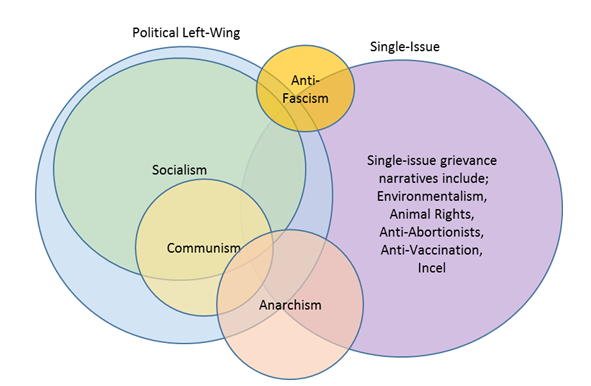What is LASIT?
Left-Wing, Anarchist and Single-Issue Terrorism (LASIT) encompasses a wide range of ideologies. It includes those from the political left-wing as well as anarchists who seek to use violence to advance their cause in opposition to the capitalist system. It also includes those with single-issue grievances who seek to use violence in opposition to a specific policy or practice.
Headline Assessment
-
We assess a terrorist attack in the UK motivated by LASIT ideology to be unlikely. The threat is low.
-
The majority of Left Wing and Single-Issue activity remains focused on protest action.
-
Single-issue grievance narratives that commonly feature within the protest space include environmentalism, animal-rights, anti-abortionists, anti-vaccination and Involuntary Celibate (Incel).
-
We currently assess that Incel-related activity in the UK remains below the terrorism threshold.
What is LASIT and what ideologies does it include?
Left-Wing, Anarchist and Single-Issue Terrorism (LASIT) is a category of terrorism that encompasses a wide range of ideologies. The relationships between these various ideologies are complex and the ideologies themselves often overlap. For example, while it might be assumed that anti-fascists who are primarily opposed to the extreme right-wing ideology are politically left-leaning, this is not always the case. At the same time, those involved with single issue concerns such as the Incel community or environmentalism might also separately embrace political ideas such as socialism or conservatism.
A LASIT terrorist’s grievance narrative may draw on several ideologies, but only one of these is likely to be predominant. This complexity is better understood by reference to the Venn diagram in Figure 1 (note that there are likely to be more overlaps of ideologies than it is possible to show with any clarity, and as a result the diagram is illustrative only and the symbol sizes and colours have no significance).

Figure 1 - Crossovers in LASIT Ideologies
In order to meet the terrorism threshold as defined in the Terrorism Act (TACT 2000), violence must be intended or used to influence the government or intimidate the public in support of an ideology. Therefore, much of LASI activity falls below the terrorism threshold.
What LASIT attacks have taken place in the West?
There has been a history of terrorist violence by left wing, anarchist and single-issue groups in the West. In the 1970s and 1980s groups such as the Red Army Faction (RAF) in Germany, the Red Brigades in Italy and Action Directe in France carried out a wave of attacks across Western Europe. By the late 1980s and 1990s these groups had disbanded following the demise of communist regimes in Europe, however violence by those inspired by left-wing and anarchist ideology has not completely disappeared.
Because of the various definitions of terrorism used by countries in the West, it is difficult to obtain reliable and comparable data on attacks motivated by LASI ideology. According to Europol, there were 24 left-wing or anarchist terrorist attacks in the European Union in 2020, yet only one in 2021. Meanwhile, the proportion of terrorist attacks and plots in the United States motivated by LASI ideology has been steadily falling over the last two decades. However, the rise of extreme right-wing terrorism has seen a corresponding increase in violent activity by anti-fascism (Antifa) groups opposed to it.
Targets of left-wing and anarchist terrorists in the West tend to be political opponents, perceived representatives of the state (notably the police and the judiciary) and major businesses. In many cases, less sophisticated methodologies such as letter and parcel bombs or arson are employed. Historically, LASIT attacks in the West have generally been less lethal than those motivated by extreme right-wing terrorist or Islamist extremist ideology. However, with little LASIT activity in the UK it is difficult to assess how this will manifest in the future.
How does LASIT manifest in the UK?
The threat from terrorism in the UK motivated by LASIT ideology is low. To date, there have been no completed LASIT attacks in the UK.
However, there have been two relatively recent disrupted LASIT plots, both of which fall into the Single-Issue category.
-
In 2019, a 22-year old man was arrested in possession of crossbow and bolts, a machete and body armour. He was subsequently found guilty of possessing articles for the purposes of terrorism under section 57 of the Terrorism Act but was cleared of another charge alleging he wanted to carry out a "spree killing". A jury at the High Court in Edinburgh found the charge that he was motivated by involuntary celibate ideology was not proven.
-
In 2021, a 38-year old man appeared at Crown Court charged with preparing terrorist acts. He was alleged to have carried out reconnaissance of potential targets, purchased equipment and tools, dug hideouts, and sought to recruit others. The plot would have targeted transmitter masts in the Midlands. He is due to stand trial in 2022.
There are currently no left-wing, anarchist or single-issue proscribed organisations in the UK and the majority of LASI activity continues to fall below the terrorism threshold. Whilst some LASI protest activity (including counter protests towards extreme right wing activity) has historically had a violent element, the majority of LASI activity falls into the category of lawful activism. Single-issue grievance narratives that commonly feature within the protest space include environmentalism, animal-rights, anti-abortionists, anti-vaccination and Involuntary Celibacy (see below).
LASI activists in the UK mobilise to undertake terrorist violence very rarely. Therefore, we assess that a terrorist attack in the UK motivated by LASIT ideology to be highly unlikely.
Where does ‘Incel’ fit in?
Involuntary Celibacy or ‘Incel’ is a single-issue grievance narrative, although it can feature alongside a range of other grievance narratives.
Incels are a loose-knit online community, predominantly comprised of men who believe they are unable to form sexual or romantic relationships due to perceived genetic inferiority, social movements such as feminism, and evolutionary traits in female mate selection. Incels harbour frustrations towards women perceived to be attractive and desirable, and men perceived to be genetically superior and sexually active. Essentially, Incels believe they are being denied sexual relationships unjustly through societal norms. They generally consider themselves to be ‘blackpilled’, which denotes a hopeless and fatalist outlook characterised by the inability to ‘ascend’ and have a sexual or romantic relationship.
Most with an Incel mindset are not perpetrators of violence. Incels are more likely to harm themselves rather than the sections of society which are the subject of their frustrations. Criminal acts by Incels are often self-serving rather than to progress an ideology and therefore do not meet the terrorism threshold. Violent acts linked to Incels in North America have targeted educational settings and leisure venues, as opposed to stadiums and event spaces. There have been a small number of violent incidents in the UK, referenced by the media as being undertaken by people aligned to the Incel subculture. Investigations have demonstrated that while the perpetrators may have shown an interest in the subculture, this was not the primary motivating factor.
We currently assess that terrorist threat from Incels is low and that Incel-related activity in the UK remains below the terrorism threshold.
Probability and Likelihood in Intelligence Assessments
When describing threats in intelligence assessments, Counter Terrorism Policing utilises the Probabilistic Yardstick.
The Probabilistic Yardstick is a tool created by the Professional Head of Intelligence Analysis (PHIA), in the UK government, to standardise the way in which we describe probability in intelligence assessments. For example, if we use the term ‘likely’ what we mean is ‘a 55-75% chance’.
Use the scale below as a reference when reading ProtectUK Insights.


